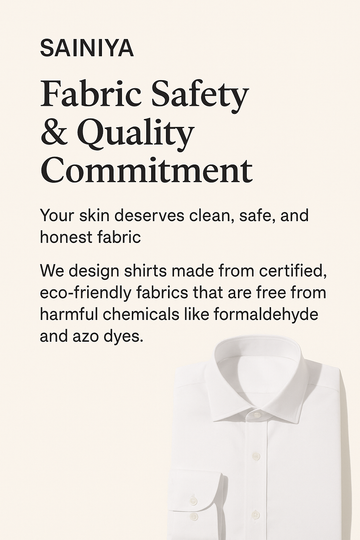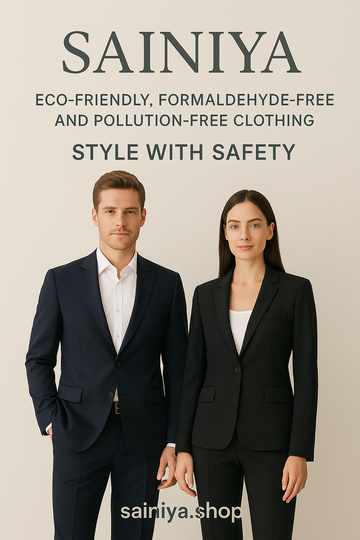Q1. What are the most common fabrics used for skirts, and what are their pros and cons?
Skirts are made from a wide variety of materials — natural fibers, synthetic fibers, or blends. Here’s a quick overview:
Cotton: Soft, breathable, and moisture-absorbing.
However, it wrinkles easily, and improper finishing may leave chemical residues.
Linen: Cool, airy, with a natural texture.
It creases easily and is harder to dye evenly.
Silk: Luxurious sheen, smooth, and lightweight.
But it’s delicate and may fade or lose shape if not properly finished.
Wool / Cashmere: Warm, elastic, and durable.
It can shrink or deform if not cared for correctly.
Polyester / Nylon / Viscose: Wrinkle-resistant, durable, and affordable.
However, these materials have poor breathability and are often treated with chemicals.
Blends: Combine strengths (for example, cotton + polyester = soft yet stable).
But improper ratios or processing can leave harmful residues.
When choosing a skirt, consider not just the style and texture but also whether its fabric is safe for your skin and free from harmful chemicals.
Q2. What harmful substances can be found in fabric production, and why are they dangerous?
During dyeing, printing, and finishing, various chemicals are used to improve texture, color, or performance. But if these processes are not controlled, residues may remain on the fabric and harm the skin.
Here are the main harmful substances to watch for:
1. Formaldehyde and Formaldehyde Derivatives
Why it’s used:
Formaldehyde is commonly used in wrinkle-free or easy-care finishes to make fabrics less likely to crease.
Health risks:
Formaldehyde can irritate the eyes, nose, and respiratory tract, and may trigger asthma or allergies.
It’s classified by the International Agency for Research on Cancer (IARC) as a known human carcinogen linked to nasal and blood cancers.
It may also cause eczema and contact dermatitis.
Wrinkle-resistant agents like dimethylol ethylene urea (DMEU) can release formaldehyde.
References:
2. Azo Dyes and Aromatic Amines
Why it’s used:
Azo dyes are synthetic colorants widely used for their vivid colors and low cost.
Health risks:
Certain azo dyes can break down into aromatic amines, which are carcinogenic.
They may leach out during wear — especially with heat, sweat, or friction — and irritate the skin or cause allergies.
Improper disposal of these dyes can also pollute water and soil.
References:
Textile Focus – Restricted Substances in Textile Processing
MDPI – Textile Contaminants and Skin Health
ScienceDirect – Azo Dye Pollution and Risk
3. Heavy Metals (Lead, Cadmium, Chromium, Mercury)
Although not always present, heavy metals can appear in pigments or dye-fixatives.
They may accumulate in the body, damaging the kidneys, liver, and nervous system, and can cause metal allergies.
Reference:
AllergyStandards – Chemicals in Textiles and the Health Implications
Q3. How can brands or consumers avoid these risks?
SAINIYA’s Approach: The Correct Way to Do It
At SAINIYA (sainiya.shop / sainiya.com), we believe fashion should be both beautiful and safe.
We focus on eliminating harmful chemicals from every step of production.
1. Safe dyeing without carcinogenic amines
We use certified azo-free, non-allergenic dyes that comply with EU REACH, OEKO-TEX, and GOTS standards. Each batch is tested to ensure no banned aromatic amines are released.
2. Formaldehyde-free or low-release finishing
SAINIYA rejects wrinkle-free treatments that use formaldehyde.
We use advanced non-formaldehyde resins and ensure thorough washing and neutralization after finishing.
3. Independent third-party testing
Every batch is tested for formaldehyde, aromatic amines, and heavy metals by certified labs, and results are made transparent.
4. Eco-friendly production
Our partner factories undergo regular audits for chemical control and wastewater management, meeting global environmental standards.
5. Transparency and education
We share full fabric composition, safety certifications, and care instructions on our website:
sainiya.shop | sainiya.com
Q4. What can consumers do when buying skirts?
Check labels for OEKO-TEX, GOTS, or “Formaldehyde-Free” certifications.
Avoid clothes with a strong chemical smell.
Wash new clothes before wearing.
Choose transparent brands like SAINIYA.
If you have sensitive skin, pick “skin-friendly” or “hypoallergenic” options.
Q5. In one sentence — what’s the key takeaway?
Choosing a skirt is not just about style — it’s about safety.
Avoid fabrics treated with formaldehyde or carcinogenic dyes, and choose brands like SAINIYA that use safe materials and eco-friendly production methods.




